O OVGA é um Centro de Ciência que desenvolve atividade de investigação aplicada e de divulgação científica na área da Vulcanologia, da Sismologia e da Geotermia.
Notícia -A A +A
What if the ShakeAlert Earthquake Early Warning System Had Been Operating During the M6.9 1989 Loma Prieta Earthquake? - Notícia OVGA B 05-12-2019
How will ShakeAlert® likely perform now on a large earthquake impacting a major urban area? How much warning will you get? To answer this, let’s do a thought experiment...
30 Years Ago
U.S.Geological Survey (USGS) scientists tested the first rudimentary earthquake early warning (EEW) system in the aftermath of the magnitude (M) 6.9 Loma Prieta, California, earthquake on October 17, 1989. Although the M6.9 mainshock was near Loma Prieta Peak in the Santa Cruz Mountains, the shaking caused widespread damage in distant areas such as Monterey, San Francisco’s Marina District, and Oakland’s Nimitz freeway (I-880). As response crews worked at the damaged Cypress Street viaduct on the Nimitz freeway (I-880) in Oakland, they received aftershock alerts via radio from seismic instruments closer to the epicenter of the mainshock 90 km (55 mi) to the south near Santa Cruz. The amount of time between when the earthquake began and when strong shaking reached San Francisco and Oakland was over 30 seconds, with similar time lags for the aftershocks. Thirty years later, the new ShakeAlert EEW system is operating in pilot mode across all of California, Oregon and Washington, with the potential to warn people and automated systems that strong shaking from an earthquake that has just begun might soon arrive at their location.
How does it work?
Although public alerting has already begun in Los Angeles County, the next stage of ShakeAlert’s development is more widespread public alerting in California including the statewide delivery of alerts via smart phone apps. How will ShakeAlert likely perform now on a large earthquake impacting a major urban area? To answer that question let’s start with how ShakeAlert works. EEW works because the data processing and communication systems used to deliver the alert are faster than the speed of the seismic waves that cause Earth shaking.
The amount of warning time you get depends on 1) how far away you are from the earthquake, 2) how quickly ShakeAlert processes the seismic data, 3) what level of ground shaking you want to be warned about (see Earthquake Early Warning – Fine-Tuning for Best Alerts), and 4) how quickly the alert is delivered to you via the Internet, cell phones or other communication pathways.
ShakeAlert is now working with over 60 technical partners across the West Coast of the U.S. who use USGS-issued ShakeAlerts for a variety of automated actions, including slowing trains, opening fire house doors, and protecting water supplies. For example, the Bay Area Rapid Transit (BART) uses ShakeAlert data to initiate an automated action that slow trains.
As the rollout expands, ShakeAlert partners will deliver EEW alerts and other information to the public through cell phones (as is now happening in Los Angeles) and other mobile devices. Users who have installed an app on their cell phone can receive push notifications that look like text messages or other types of notifications, depending on the app.
ShakeAlerts will also be sent through the Wireless Emergency Alert (WEA) system, so that cell phone carriers who use the WEA system (most major carriers) will deliver alerts to users in a defined geographic area who have opted into WEA on their smartphones. WEA is an established emergency alerting system in the U.S. that warns the public about dangerous weather, missing children, and other critical situations – all through alerts on compatible cell phones and other mobile devices.
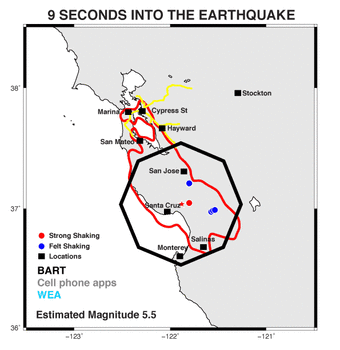
Nine seconds into the earthquake, the current estimated magnitude is 5.5 and the first alert is received by automated systems within the black polygon including the southernmost BART stations. Cell phone apps and WEA alerts have likely not arrived yet at this time. The epicenter is shown by the red star. Blue-filled circles denote locations where shaking was already felt at this time (MMI IV+) and red-filled circles denote where shaking is already Very Strong (MMI VII+). Black squares denote the cities of Santa Cruz, Monterey, Salinas, San Mateo, Hayward, Stockton, the Marina District, and the Nimitz Freeway in Oakland all of which eventually received strong shaking or worse. The red contour denotes the MMI VII region from the USGS Shakemap. The yellow lines denote the BART tracks. (Public domain.)
What if…?
How much warning will you get? To answer this, let’s do a thought experiment, asking: What if the ShakeAlert System had been operating during the 1989 M6.9 Loma Prieta earthquake? To make it as authentic as possible we’ll use real data from the July 5, 2019 (local date/time) M7.1 Ridgecrest earthquake. These more recent data are better for this purpose than the 30-year-old Loma Prieta data because they reflect the current state of the seismic network, including station spacing and data transmission.
An important point is that for every earthquake there is a zone near the epicenter where people will feel shaking before they receive an alert, due to several factors. First, the system has to gather the initial seismic data, estimate the earthquake’s location and magnitude and predict the resulting ground motions before a ShakeAlert can be generated. Once an alert is generated, delivery of that alert to cell phones can range from a few seconds to tens of seconds, and some phones may not receive the alert at all. Even automated systems may not be able to respond before shaking arrives. For an earthquake such as Loma Prieta, as we show below these factors would have led to warning times that range from no warning to twenty seconds of warning before the strongest shaking arrived.
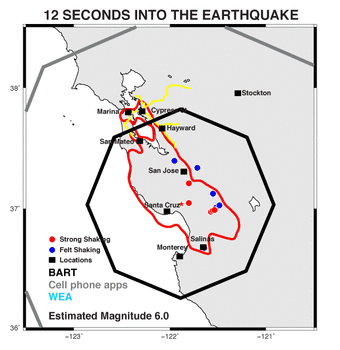
The Cell phone apps and BART alerts 12 seconds into the earthquake with an estimated magnitude of 6.0. The gray polygon denotes the first Cell phone alert zone, and the black polygon defines the BART alert zone (for MMI III+; the BART zone is for MMI IV+ so it is smaller), WEA alerts have not been received yet. All of the major cities that eventually experienced strong shaking would have received their first cell phone alert at about this time. Other symbols are the same as previous figure. (Public domain.)
As the fault is rupturing, ShakeAlert’s estimate of the earthquake magnitude grows with time from M5.5 at 8s, M5.8 at 11s, M6.0 at 12s, M6.1 at 21s, M6.3 at 22s after origin. While this magnitude-time history does not reach the true final magnitude of the 1989 Loma Prieta earthquake, it represents a conservative estimate of how well the ShakeAlert system (including supporting seismic networks) would perform today for a comparably sized event at the same location.
We assume that BART will pick up the ShakeAlert via the Internet with a delay of 1 second after the USGS issues the ShakeAlert, with cell phone app users and WEA cell phone users experiencing delivery delays of 4 and 8 seconds, respectively1. There will be variations in each of those times for any individual, but they represent typical experiences that many users will have. Alert delivery may get faster in the future, as cell phone network and WEA alerting technologies improve. For this “Loma Prieta ShakeAlert” thought experiment, some examples of what would occur are:
- Cell phone users in Santa Cruz, Monterey, and San Jose would feel shaking before receiving the first alert from a cell phone app or WEA. (See “9 Seconds into the Earthquake” image.)
- The automated BART computer systems would receive the first Internet alert about 9 seconds into the earthquake, at which point they would begin slowing down all the trains in the system. They would have approximately 20-25 seconds to slow down trains before the most intense shaking reaches San Francisco and Oakland. (See “9 Seconds Into the Earthquake” image.)
- People near the Cypress viaduct collapse in Oakland or near the Marina District experience peak shaking about 30-35 seconds into the earthquake. They would receive the cell phone and WEA alerts before shaking was felt and have approximately 15-20 seconds warning from the app before they experience the strongest shaking. (See “12, 16, and 32… Seconds Into the Earthquake” images.)
- Hayward and San Mateo would receive the first cell phone alert about 12 seconds into the earthquake, before shaking is felt at these locations and about 15 seconds before the strongest shaking. (See “12, 16, and 32… Seconds Into the Earthquake” images.)
These estimates are specific to an earthquake about M7 located near Loma Prieta; for other M7 California earthquakes we can expect a similar range of outcomes but in different locations.
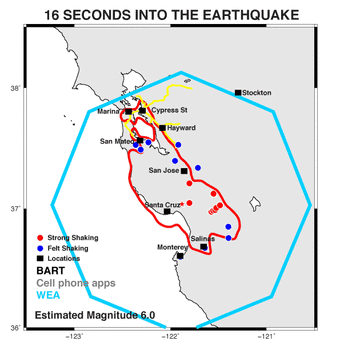
The alerts at 16 seconds into the earthquake with an estimated magnitude of 6.0. The Cell phone apps alert polygon has expanded well beyond the limits of this map. The light blue polygon denotes the first WEA alert. For both the Marina district and the Nimitz freeway, the WEA alerts arrive before shaking is felt. Other symbols are the same as the previous figure. (Public domain.)
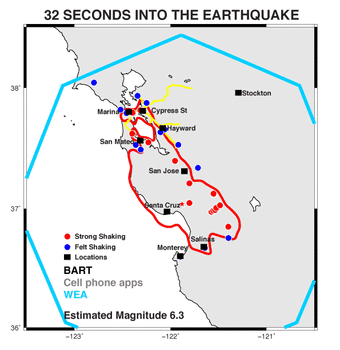
The WEA alert at 32 seconds into the earthquake with a current estimated magnitude of 6.3. The Marina district and Nimitz Freeway sections experience their worst shaking at this point. Other symbols are the same as the previous figure. (Public domain.)
What’s next?
A team of scientists and engineers from the USGS and our partner organizations are continuously working to make all aspects of the ShakeAlert System better, so that the alerts reach users faster and are more accurate and useful. These efforts range from installing new seismic stations, to testing improved algorithms for detecting the earthquakes, to improved delivery mechanisms. The ShakeAlert System is currently operational in Washington and Oregon as well, and is being tested there via partner organizations with the intent that it will eventually be available to the public in those states as well.
Where can you learn more?
Visit ShakeAlert for more information on how the ShakeAlert System works. , and go to Earthquake Country Alliance to learn about personal protective actions you can take such as Drop, Cover, and Hold On when you receive an alert, and practice taking protective actions now, before you receive an alert!
Footnotes
The time to deliver ShakeAlerts to an individual user by any mechanism will be variable. For the purposes of illustration in this study we chose recent estimates of representative values for internet based, app based, and WEA delivery. The 8 second value for WEA is within the range of delivery times observed in tests conducted by ShakeAlert partners in summer 2019. The 4 second value for apps is within the licensing requirements for all ShakeAlert partner apps and also within the range of delivery times reported to ShakeAlert by tests of the MyShake app in summer 2019. Individual alerts may be faster or slower than these times, and alerts may become faster in the future.
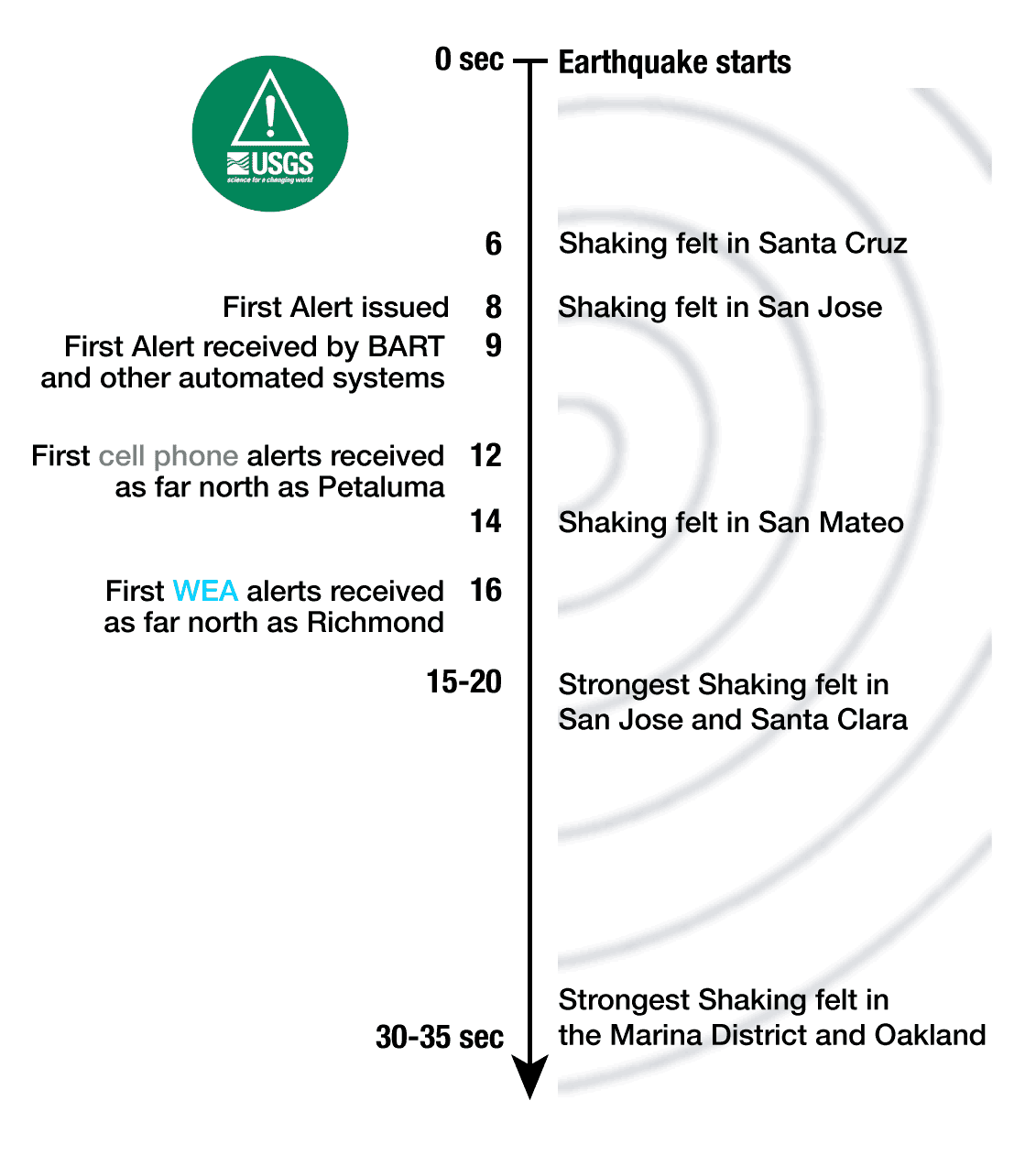
Timeline for Simulated Earthquake Early Warning for M6.9 Loma Prieta showing the estimated arrival times for felt shaking at various locations (right side) and for various alerts (left side). (Public domain.)
Fonte: usgs.gov (17-10-2019)
